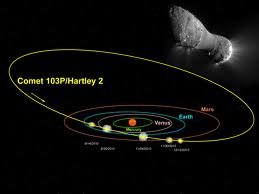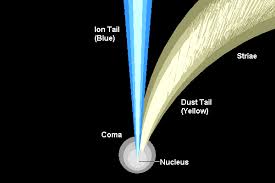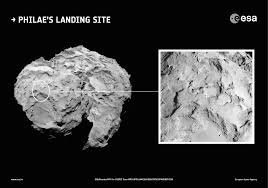Overview
Comets are small icy rocks that belong to the solar system. Many have highly elliptical orbits that pass close to the sun. As they heat, they begin to vaporize, forming a tail of gases and dust. Many comets, such as Halley’s Comet, are regular and predictable, and have been the sources of legends throughout human history. In November 2014, a space probe landed on a comet, in an effort to add to knowledge about them.
Study of Comets
Comets have fascinated humanity from earliest times. Ancient Chinese astronomers described their passage across the night skies from the 15th century BCE on. Comets were bringers of woe, doom, calamity, and catastrophe. Bright hairy stars were different from other phenomena in the night sky. They appeared to move across the sky, becoming brighter and showing strange fiery tails. They faded away rapidly, unlike other stars or planets.
Orbit of Comets
Astronomer Edmond Halley, who was interested in the movement of objects in the heavens, visited the mathematician and scientist Sir Isaac Newton in 1684. Newton discussed the mechanics of planetary orbits in works that would become the Principia Mathematica. Halley developed a mathematical theory, based on Newton’s formulation, that comets followed regular, predictable, highly elliptical orbits. He predicted that the comet that bears his name would return in an orbit around the sun that lasts 74 years. Over five thousand comets have since been charted. Many have periodic orbits that last less than 200 years, while others are theorized to take many thousands of years to orbit the sun. Comets tend to move slowly when they are further away from any light or heat, and move more quickly the closer they get to the sun.
Composition of Comets
The solid core of comets consists of rock, dust, and various forms of ice, including water, methane, ammonia, and frozen carbon dioxide. In addition, the nuclei can contain some amino acids and other organic compounds much as methanol. As dust and gas is heated and released, it forms an atmosphere called the coma, which streams beyond the nucleus as the gases are heated, creating the tail. Comets are thought to come from vast interstellar clouds, called Oort clouds, that may have been left over from the formation of the solar system.
The Rosetta Mission
A number of flyby probes have taken pictures of comets, but only one has landed on a comet nucleus. The European Rosetta mission landed a probe in November 2014. Although the probe has lost power when it landed too near a dark cliff, scientists think that its batteries may recharge when the comet itself moves closer to the sun. The lander Philae will be heated enough to move to a better spot on the nucleus than where it landed.
Interested in science tutoring services? Learn more about how we are assisting thousands of students each academic year.
SchoolTutoring Academy is the premier educational services company for K-12 and college students. We offer tutoring programs for students in K-12, AP classes, and college. To learn more about how we help parents and students in Lowell, MA: visit: Tutoring in Lowell, MA




